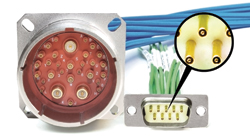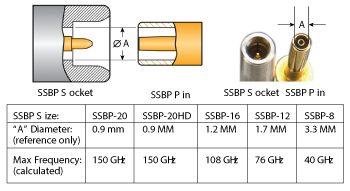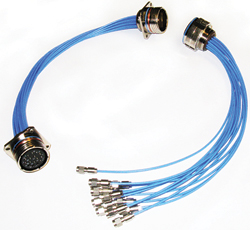
Electronic equipment has evolved significantly over recent decades, both in terms of performance and packaging. A myriad of advancements in device engineering in the commercial, military and scientific sectors have contributed to components and end systems that are more sophisticated and much smaller than their predecessors. For example, today’s unmanned vehicles have greater range as a result of optimized energy sources and reduced craft size. Satellites that communicate from deep space are constructed from compact, lightweight materials to reduce launch costs. Surgical procedures are more minimally invasive through robotics and microscopic tools.
Yet as end solutions evolve in function and form, microwave coaxial connector solutions have been slow to keep pace with the complex interconnect cabling requirements to support these new generation technologies. In an age of miniaturization, legitimate concern exists relative to the heavy weight and extensive space needed for individual connector mounting, between-connector spacing, and manual mating of each connector and cable. If intricate harnesses are developed to organize a maze of interconnections, system cost grows. If not, field maintenance is extensive and expensive. Finally, the range of connectors commonly needed to address the varying frequency demands of today’s electronic products further increase PCB or panel area and project budget.
There are also interconnect quality issues that can negatively affect reliability. Standard push-on RF connectors can separate under the vibration or shock of a harsh environment. Poor connector grounding equals poor RF performance and shorter system mean time between failures (MTBF). Similarly, without a built-in stress release, a soldered center conductor is a failure point for many of today’s coaxial cable assemblies. In a spec where the potential for mismating of cables is prohibited, reverse-sex plug-jack combinations, polarized (keyed) connectors or pairing of dissimilar connectors can solve the problem, but at high cost.
As systems expand in capability but shrink in size, there is a distinct need for multifunctional microwave interconnect solutions that support higher RF frequencies, greater bandwidth, improved survivability, easier servicing and a more compact footprint.
The SSBP Advantage
To provide a reliable alternative to the packaging challenges of traditional interconnect cabling, Southwest Microwave has developed a family of SSBP RF and microwave coax contacts. SSBP coax contacts conveniently seat in cavities designed for signal (non-coax) contacts in off-the-shelf multiport connectors that use M39029 contacts. For maximum design flexibility, SSBP contacts for special applications, including discrete coax installations, can be arrayed in custom envelopes. Seating or removal of SSBP contacts is achieved using standard MIL-I-81969 insertion and extraction tools.

Figure 1 SSBP size (using signal contact sizing terminology) vs. millimeter wave transmission line diameter "A". The maximum frequency depends on contact size and cable application.
SSBP coax contacts achieve a single, high performance connection to device cabling that can be easily connected and disconnected as needed, rather than mating an array of individual RF connectors. This simplifies interconnections and cabling, especially in tight or hard to reach spaces, dramatically reducing field maintenance or system test requirements and contributing to reductions in end-system cost. The miniaturized SSBP RF packaging format enables significant space and weight savings, versus discrete connectors and cables, by reducing the necessary area and volume of interconnections.
SSBP solutions offer higher RF performance and greater bandwidth than a corresponding array of individual connectors. Coax contacts of varying frequencies can easily be housed in one multiport connector or mixed with DC power, signal and fiber optic contacts to optimize multi-functionality, packaging design flexibility and project cost savings.
For circular connector applications, SSBP size 20, 16, 12 and 8 contacts are available to seat in standard MIL-DTL-38999 connectors with size 20, 16, 12 and 8 contact cavities. In rectangular connector applications, SSBP size 20HD coaxes seat in size 20 contact locations in standard MIL-DTL-24308 D-Subminiature connectors. SSBP 20HD assemblies used in D-Sub applications are also used in low profile, ruggedized, board-launchable MIL-DTL-83513 Micro-D type connectors in 3, 6 or 9-pin configurations. Figure 1 shows the SSBP size versus millimeter wave transmission line diameter “A”. The maximum frequency depends on contact size and cable application.

Figure 2 SSBP high performance coax contacts for use in standard MIL-DTL-38999 and other multiport connectors solve the space, weight and performance challenges of standard interconnect cabling.
For miniaturized applications, SSBP contacts retrofit into Glenair Mighty Mouse® Series 79 and 80 connectors, and can be designed for use in other types of multi-pin connectors. SSBP high performance coax contacts for use in standard MIL-DTL-38999 and other multiport connectors (see Figure 2) solve the space, weight and performance challenges of standard interconnect cabling.
SSBP coax design ensures exceptional RF performance and longevity, particularly in harsh environments. Pin and socket construction offers built-in contact stress relief during mating, as does a positive, three-step mating sequence in the host connector that accurately aligns the contact’s outer conductor prior to engaging the center conductor, which guarantees matched impedance and EMI-tight, repeatable mating. Spring-loaded contacts maintain a constant ground path through shock or vibration and have no exposed spring fingers or slots that could be damaged or allow EMI emissions. Termination of SSBP contacts does not involve soldering of the cable center conductor to the socket contact, preventing breakage due to cable movement.
MIL-HDBK-217F, Notice 2 outlines that coaxes in multi-pin connectors are predicted to have higher reliability, or longer MTBF, than groups of equal numbers of discrete coaxes. Coupling this data with the highly positive outcomes of SSBP coax testing for vibration, shock, mating/unmating durability, EMI shielding effectiveness and typical microwave performance reinforces the viability of these solutions for hi-rel or harsh environments.
Broad-Ranging Applications
Systems with complex signal generation and routing requirements – such as communications, radar or missile defense systems – call for a high volume of RF interconnects. The higher the volume of RF interconnects, the more applicable the SSBP solution. The small footprint and reduced weight of numerous SSBP coax contacts housed in a multiport connector also make this solution ideal for interconnect applications where weight and space are concerns, such as the tight spaces of on-board computers, landing gear, microsurgical equipment or unmanned systems.
With the environmentally sealed, ruggedized packaging of the D38999 connector housing, SSBP contacts will withstand the shock and vibration inherent in aerospace or military applications. By facilitating instant and reliable mating of a complex array of interconnections with a single multiport connector, SSBP coaxes reduce the potential for mating error and connector damage, and add efficiency to highly-regulated electronic system performance testing applications, such as aircraft system testing, where the manipulation of individual interconnections adds extensive data logging and cost to the testing process.
Southwest Microwave Inc.
Tempe, Ariz.
(480) 783-0201
www.southwestmicrowave.com
